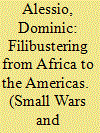| Srl | Item |
| 1 |
ID:
148049


|
|
|
|
|
| Summary/Abstract |
This article looks at dominant definitions of empire, in particular those emphasizing large polities as the sole agents of imperial expansion. By doing so, it draws attention to the overlooked role of filibusters: private, non-state actors who initiate unauthorized military endeavours, either in an attempt to carve out empires for themselves or for their home state. It demonstrates that filibustering is not a practice unique only to the Americas or to the nineteenth century as so much of the literature suggests. Lastly, it scrutinizes the cultural and historical impact of the phenomenon. In terms of the former, it argues that filibustering had an important literary and filmic influence. Regarding the latter, it advocates that it frequently led to further violent intercessions in many of the countries occupied and influenced a particular style of proto-fascistic and charismatic militarism.
|
|
|
|
|
|
|
|
|
|
|
|
|
|
|
|
| 2 |
ID:
168206


|
|
|
|
|
| Summary/Abstract |
In the decades following independence from Spain, ‘civil wars’ ravaged the newly established polities in South America. Former vice-regal capitals inherited a larger portion of the colonial administration and had larger economic resources and a hegemonic project they were able to have permanent and professional armed forces, capable of leading the offensive and giving battle following the European rules of military art. The central hypothesis of this work is that there is a necessary relationship between the shape of these asymmetrical conflicts, their outcome and the political territorial configuration of each country in post-revolutionary Spanish America. When permanent armies took over from local militias, the capital kept the integrity of its territories and there was a tendency towards political centralization. When this did not happen and the militias managed to find a way to defeat their centralizing enemies, the local powers had an opportunity to renegotiate their participation in the political body, and sought to maintain their independence, which was manifest in federal agreements, otherwise a process of territorial fragmentation began. More than a difference between regular and irregular forces there was one between intermittent, and permanent mobilization.
|
|
|
|
|
|
|
|
|
|
|
|
|
|
|
|